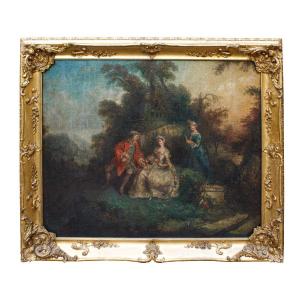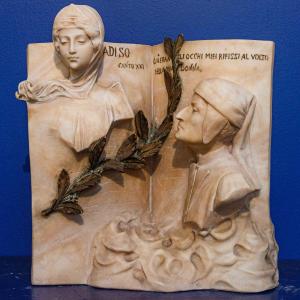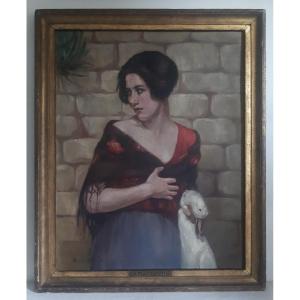Portrait of a lady
Oil on canvas, cm 120 x 97
This portrait shows a noblewoman richly dressed, according to the fashion of the second half of the seventeenth century. In this phase we gradually move to a kind of clothing that follows, for both men and women, the French costume instead of the Spanish one, widely used in the previous century until the first decades of the seventeenth century. The emphasis on the female body through the narrow corset, a kind of forerunner of the corset, and the wide neckline that left the shoulders free. To these more daring cuts must be added, however, a greater preciousness in the lace ornaments along the neckline, on the edges of the puff sleeves and in the pearls that cover the central area of the chest; as accessories we can immediately notice the fan in black feathers to which is tied a red ribbon perfectly matching with that which is wrapped on the spectacular hairstyle of the lady, in which you immediately notice the new taste towards a fold that prefers the curl and that collects in high crunches on the back of the head. In particular, this type of hairstyle, stopped by the ribbons, began to rise vertically in the compositions and became a kind of imitation of tall curly wigs used by men from the eighties of the century; called Fontange from the name of the duchess of Fontages, lover of Louis XIV, it became more and more complex thanks to the use of ribbons, bows, pins and headphones, aimed at supporting the imposing curly structure. The candied skin of the woman is reflected in the prerogative for the ladies to have a white color, also through the use of makeup, symbol of nobility and a high-class lifestyle, away from the hardships of working outdoors and its tanning due to the sun. Among the Italian schools of painting, that of Lombardy appears as the closest to this portrait, which is painted from the natural and fits in the vein of painters that Roberto Longhi called "of reality", among which there are several portraiture artists active in the region between the sixteenth and eighteenth century: starting from Moroni to Giacomo Ceruti passing by Carlo Ceresa and Pier Francesco Cittadini, the latter perhaps easier to approach periodically to our portrait, The aspect of investigation of the real, both in objects and characters, is a fundamental element of the work. Also in this case, we find a posture certainly sustained, a noble and composed submissiveness, but in which you immediately notice a more intimate and human emotional resonance that seems to want to go beyond simple imitation.




























 Le Magazine de PROANTIC
Le Magazine de PROANTIC TRÉSORS Magazine
TRÉSORS Magazine Rivista Artiquariato
Rivista Artiquariato